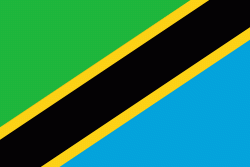Karatu (Karatu)
Karatu or Karatu Town (Kata na Mji wa Karatu in Swahili) is an administrative ward and district capital located in the Karatu District of the Arusha Region of Tanzania. The ward town is bordered on its north side by Ganako ward, to the east by Rhotia ward, to the south by Endamarariek ward, and to the west by Qurus ward. According to the 2012 census, the ward has a total population of 26,617. Karatu ward is the most populous ward in Karatu district and is the capital of Karatu District.
Karatu is a small town in the Arusha District, excellently positioned on the borders of Lake Manyara National Park and Ngorongoro Crater, giving it the nickname 'Safari Junction'. It is frequently utilized as a quick stopover in between safari expeditions or as a less expensive lodging alternative than staying on the rim of the Crater and within Lake Manyara National Park.
The Karatu Market - On the 7th and 25th of each month, local sellers will gather in Karatu for a large market, giving you the opportunity to admire finely created things, purchase souvenirs, and practice your haggling abilities. The market on the 25th is a little smaller, but if none of these dates work for you, there is a daily small market in the town center.
Karatu is a small town in the Arusha District, excellently positioned on the borders of Lake Manyara National Park and Ngorongoro Crater, giving it the nickname 'Safari Junction'. It is frequently utilized as a quick stopover in between safari expeditions or as a less expensive lodging alternative than staying on the rim of the Crater and within Lake Manyara National Park.
The Karatu Market - On the 7th and 25th of each month, local sellers will gather in Karatu for a large market, giving you the opportunity to admire finely created things, purchase souvenirs, and practice your haggling abilities. The market on the 25th is a little smaller, but if none of these dates work for you, there is a daily small market in the town center.
Map - Karatu (Karatu)
Map
Country - Tanzania
 |
 |
| Flag of Tanzania | |
Many important hominid fossils have been found in Tanzania, such as 6-million-year-old Pliocene hominid fossils. The genus Australopithecus ranged across Africa between 4 and 2 million years ago, and the oldest remains of the genus Homo are found near Lake Olduvai. Following the rise of Homo erectus 1.8 million years ago, humanity spread all over the Old World, and later in the New World and Australia under the species Homo sapiens. H. sapiens also overtook Africa and absorbed the older species of humanity. Later in the Stone and Bronze Age, prehistoric migrations into Tanzania included Southern Cushitic speakers who moved south from present-day Ethiopia; Eastern Cushitic people who moved into Tanzania from north of Lake Turkana about 2,000 and 4,000 years ago; and the Southern Nilotes, including the Datoog, who originated from the present-day South Sudan–Ethiopia border region between 2,900 and 2,400 years ago. These movements took place at about the same time as the settlement of the Mashariki Bantu from West Africa in the Lake Victoria and Lake Tanganyika areas. They subsequently migrated across the rest of Tanzania between 2,300 and 1,700 years ago.
Currency / Language
| ISO | Currency | Symbol | Significant figures |
|---|---|---|---|
| TZS | Tanzanian shilling | Sh | 2 |
| ISO | Language |
|---|---|
| AR | Arabic language |
| EN | English language |















